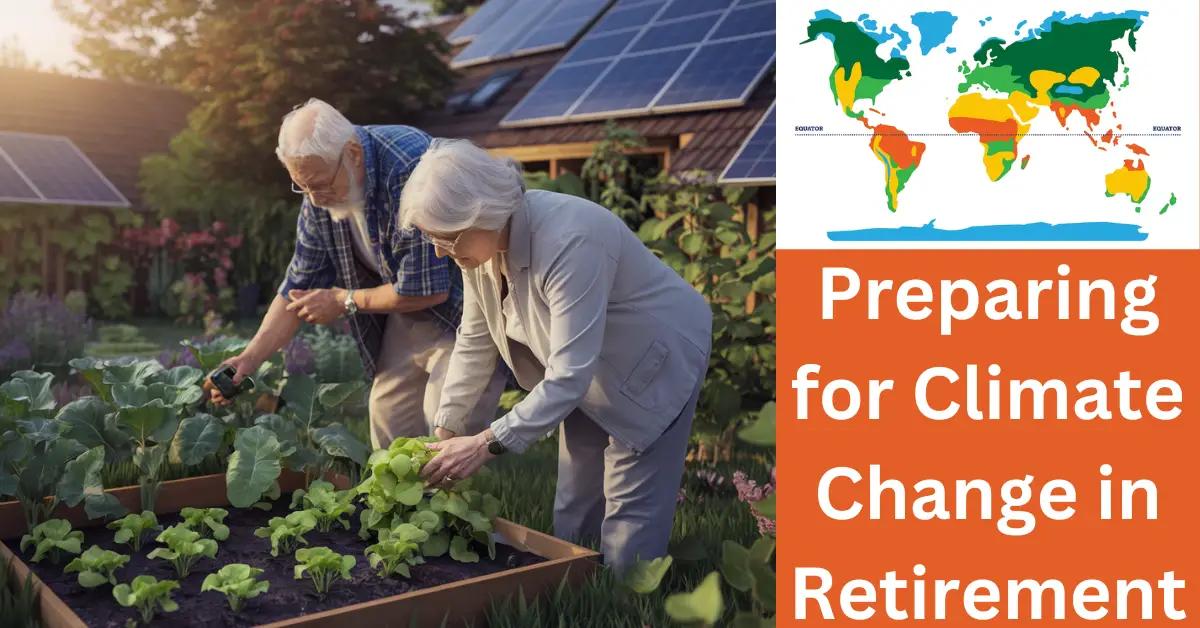TL;DR:
- Retiring in climate-stable areas like the Northeast U.S. and states such as Maine and Vermont is advisable for fewer climate risks and natural disasters.
- Healthcare access and strong local climate policies are crucial in retirement location decisions.
- Climate change affects retirement by raising expenses and necessitating tailored financial strategies, including climate-related insurance and pension funds in green tech.
- Embrace sustainable living through eco-friendly communities, energy-efficient upgrades, and zero-waste practices to lower carbon footprints.
- Prepare for warmer climates with appropriate healthcare planning and insurance suited to climate risks.
- Home modifications, like energy efficiency improvements and smart tech, enhance climate resilience.
- Building robust community networks aids in climate adaptation through shared resources and knowledge.
- Investing in clean energy can reduce costs and offer financial and environmental benefits, though carries market risks.
Retirees face a new challenge: where is the best place to live as our climate changes? "Preparing for Climate Change in Retirement: Are You Ready?" opens the door to exploring this pressing issue. From uncovering which states offer stable climates to discussing the influence of local policies, this guide helps you find the safest place for your golden years. Dive into the exploration of favorable retirement spots with me, and let's plan for your climate-resilient future.
Where Can Retirees Find the Best Places to Live Considering Climate Change?
Finding the ideal spot for retirement amid climate change can be a challenge. So, where is the best place to retire for climate change? Pinpointing such a place requires looking at areas less at risk from climate problems. The Northeast U.S. stands out as a prime region. It’s known for modest climate changes and fewer natural disasters. This makes it a strong candidate for retirees.
But what state has the best climate to retire in? States like Maine, New Hampshire, and Vermont are often considered. These areas, with their stable climate records and less exposure to climate volatility, are worth considering. Their natural landscapes also offer peace while minimizing excessive heat or severe weather events.
Tools and resources can aid in finding stable climates. Websites and apps analyze climate data for future projections, helping retirees assess potential spots. They offer insights into long-term climate patterns, ensuring informed decisions. This helps avoid areas with greater climate impacts.
It's vital to think about proximity to healthcare while considering retirement locations. Being near good hospitals and medical services is key. These services need to be resilient to climate impacts, ensuring they remain accessible despite natural challenges.
Further, the local government's policies on climate resilience are crucial. Communities that prioritize sustainability and climate action offer better protection. Their efforts in infrastructure, green spaces, and community programs increase security during climate threats.
Therefore, when considering where to retire, I focus on stable climates first. Together with healthcare access and strong community policies, I can find a suitable place. Crucially, this also requires staying engaged with local developments on climate policies. In this way, I ensure my peace of mind and safety in retirement through strategic location choices.
How Does Climate Change Affect Financial Planning for Retirement?
Climate change impacts your retirement planning by affecting costs and financial risks. The main question is, “What is the financial impact of climate change on retirement planning?” The answer involves rising expenses, like increased energy bills or insurance premiums. Climate change can also affect where you can afford to live comfortably.
The cost of living in retirement goes up due to climate impacts. Warmer summers mean higher cooling costs, and extreme weather means more home repairs. It's crucial to plan for these costs to avoid surprises later.
You need strategies that include climate risks in your retirement plans. Start by assessing your current situation. Think about where you live and the local weather patterns. This will help you understand and prepare for increased costs.
Consider insurance policies covering climate risks as part of your plan. Some policies can offer protection from damages caused by storms or flooding. Talk to a financial adviser who knows about climate-related advisement. They can help tailor your plan to include these risks.
Think about how your pension fund deals with climate policy impacts. Some funds invest in green technologies or have policies to deal with climate change. Ask questions and choose a fund that aligns with your values and plans.
Use tools that assess your readiness for extreme weather events. Some online tools help find weaknesses in your financial plans related to climate change. This can guide you in making better decisions.
Finally, reducing your carbon footprint can lower some retirement costs. Changing how you travel, manage energy use, and use resources helps. Guides on lowering carbon-linked costs are widely available to assist you.
What are Sustainable Living Options for Retirees Adapting to Climate Change?
Retirement is when you can explore new ways to live, especially with climate change in mind. Sustainable living options for retirees abound. Eco-friendly retirement communities, for instance, offer green spaces, solar power, and rainwater collection. These places help reduce your carbon footprint while keeping you close to nature.
Have you thought about cohousing or cooperative housing? These options help retirees share resources and cut costs by living together. You share gardens and common areas, making living more sustainable and enjoyable.
Energy-efficient upgrades for senior housing might seem like an extra cost, but they save money. Installing LED lights or an energy-efficient heater can lower your bills. Consider upgrades like better insulation or new windows, which also help.
Embrace a sustainable diet by buying local produce. If you have a garden, you can grow your vegetables. Eating fresh and local cuts down on transportation-related emissions.
Zero waste living is key. Start with simple steps like composting kitchen scraps or using reusable shopping bags. Reduce, reuse, and recycle as much as possible to minimize waste.
Finding communities focused on sustainability is easier now. Search online for groups or forums dedicated to sustainable living. Joining these communities offers support and inspiration for eco-friendly living.
Together, these living options and practices pave the way for a greener retirement. It's about making choices that lead to a healthier planet while enjoying your golden years. Sustainable options not only benefit the Earth but also bring joy and satisfaction. You become part of a larger effort to make the world a better place, all while living comfortably.
How Should Healthcare Planning Change in Warmer Climates?
Moving to a warmer climate can greatly affect your healthcare needs. When temperatures rise, seniors face added health risks. Heat can worsen chronic conditions and increase dehydration. It’s crucial to stay hydrated and use preventative health measures. This is the first step to managing health in hotter climates.
Key health considerations for seniors include monitoring possible heat-related illnesses. You should be vigilant for signs of heat stroke or exhaustion. Symptoms like dizziness or confusion need quick attention. Recognizing these climate-related health issues can save lives.
Your medical insurance might need adjustments. Warmer climates can introduce new health risks. Check if your coverage includes ailments common in hot weather. Some plans offer specific options for such risks. This may include consults with specialists familiar with climate impacts.
Technology plays a role in healthcare planning too. Devices can monitor heart rates and fluid levels, giving real-time updates. These aids are crucial in maintaining health when temperatures soar. They can alert you to problems before they become serious health issues.
A list of healthcare practices adaptable to high temperatures includes wearing light clothing, using fans or AC, and avoiding the sun during peak hours. Regular health check-ups ensure early detection of heat-induced conditions. During such visits, discuss with doctors how climate impacts your health.
Planning for climate change in retirement involves more than location. It's essential to prioritize your health as the environment shifts. Developing a thorough health strategy for hotter climates requires addressing these varied aspects and planning accordingly. If you need more tailored tips, consider checking resources or guides about healthcare needs in warmer climates.
What Home Modifications Can Ensure Retirement Housing Is Climate-Resilient?
Preparing your home for climate change is crucial during retirement. So, what home upgrades are necessary for adapting to climate change during retirement? Focus on climate resilience features all retirees need. Begin with fortifying your home against storms. Retrofitting with storm-resistant materials like impact windows can safeguard your abode.
Consider your home's energy efficiency. Cost-effective improvements can be made without breaking the bank. Seal doors and windows, and install insulation to save on energy, keeping your home cool in the heat and warm in the cold. You will also want to consider renewable energy options. Solar panels and wind turbines can cut electrical costs while reducing your carbon footprint.
Next, install advanced water management systems. These systems conserve water and reduce flood risks. Rainwater collection, drought-resistant plants, and efficient plumbing are part of this setup. They ensure your home is ready for water-related challenges, whether too much or too little.
Don't forget technology's role in your preparations. Smart home tech offers innovations to improve climate resilience. Smart thermostats, grid-integrated energy systems, and weather-sensitive irrigation can all ease your adaptation efforts. As you plan these changes, think about leveraging the tech to monitor home conditions actively.
By adding these modifications, your retirement home can stand strong against climate change. Retirement is not only about relaxation but also about smart preparation for future challenges. Implement these upgrades, and you'll create a safe, comfortable, and eco-friendly living space that cares for both you and the planet.
How can retirees create robust support networks for climate adaptation?
Community networks are a lifeline for retirees facing climate change. They help us share resources and knowledge. Through local adaptation programs, we learn to make our communities stronger. These programs show us how to handle weather changes and keep everyone safe.
Participating in community planning is key. It lets us voice our needs and ideas. This involvement helps shape how our community prepares for climate impacts. By joining planning meetings, we ensure all needs, especially those of seniors, are met.
Intergenerational knowledge exchange creates bonds. Young people can teach technology use for climate monitoring. In turn, older folks share wisdom about the environment. This exchange benefits all generations and strengthens community ties.
Community-focused volunteer initiatives offer another way to get involved. These programs provide support during emergencies. They can also guide us in reducing our own impacts on the climate. Volunteers often lead projects like tree planting or energy conservation drives.
Finding peer networks of eco-conscious retirees is helpful too. These groups discuss climate topics and actions. Sharing our experiences can inspire more sustainable choices. Eco-conscious networks often work on projects like community gardens or recycling programs.
Embracing technology is vital for coordination. Apps help us organize community activities and alerts. They ensure everyone is informed of climate news or events. Tech tools track weather changes and help in emergency planning. They keep communication lines open among members.
As we embrace these community aspects, we adapt better to climate changes together. By strengthening community networks, we enhance resilience and build a supportive environment for all.
What Role Does Investing in Clean Energy Play in Retirement Planning for Climate Change?
Investing in green energy can be smart and bring benefits to both your wallet and the planet. How can investing in green energy benefit retirees financially and environmentally? Precision: Investing in green energy can lower bills and support the Earth. This is true because choosing renewable energy can save money over time. It usually needs an upfront cost, but the savings add up.
Green energy investments are not without risks. The stock market can be unpredictable. It is wise to learn about ethical investments that yield good returns. Look for companies that focus on clean energy and sustainability. These companies often have better long-term growth because they care for the environment.
Climate-focused investment portfolios are another way to go green. These portfolios include stocks in wind, solar, and other renewable resources. If interested, find financial advisers who understand these investments.
Long-term profits from clean energy look promising. As more people and governments opt for green solutions, demand increases. This demand can boost the value of clean energy stocks over time.
Starting at home can also be a good step. Renewable energy adoption in retirement can include using solar panels or wind turbines. These help lower energy bills, and sometimes, the government offers rebates. Checking local programs can be useful.
If unsure where to start, try tapping into educational resources. Many organizations offer materials on green energy. Websites like Renewable Energy World provide news and guides on the topic.
With the right approach, investing in clean energy could safeguard your retirement against climate change, while making your lifestyle more sustainable. Choosing wisely means staying informed and seeking guidance when needed.
Conclusion
Finding the right spot to retire in a changing climate is vital. We've explored regions with reliable climates and state choices considering future weather. Tools help you check climate stability in your desired area. Nearby healthcare and community plans are crucial too. Don't forget that climate change affects your expense planning. Adjust your money management and consider clean energy for eco-friendly living. Building a strong support network can make your journey smoother. By taking calculated steps now, we will ensure a stable, sustainable, and enjoyable future in retirement.












